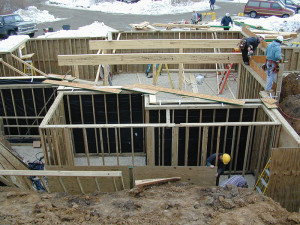The 2015 Permanent Wood Found-ation (PWF) Design Specification addresses structural design requirements of wood foundations for light-frame construction. The standard for designing wood foundations is most commonly used in residential structures in the upper Midwest. The 2015 PWF standard is adopted by reference in the 2015 International Building Code (IBC) and the 2015 International Residential Code (IRC).
Updated from the 2007 version, minimal changes are included in the 2015 PWF. These include updated references to the following standards:
- 2015 National Design Specification® (NDS®) for Wood Construction
- 2015 Special Design Provisions for Wind and Seismic (SDPWS).
- American Softwood Lumber Standard, PS 20-10
- Construction and Industrial Plywood Standard, PS 1-09
- Performance Standard for Wood-Based Structural-Use Panels, PS 2-10
- Use Category System: User Specification for Treated Wood (Use Category 4B: Permanent Wood Foundations), American Wood Protection Association (AWPA) U1-14
A PWF system consists of a load-bearing wood-frame wall and floor system designed for both above and below-grade use as a foundation. Properly designed, a PWF can be engineered with stress-graded lumber framing and plywood sheathing to support lateral soil pressures as well as dead, live, snow, wind, and seismic loads. The 2015 PWF includes criteria for materials, preservative treatment, soil characteristics, environmental control, design loads, and structural design.

Properly designed, a PWF can be engineered with stress-graded lumber framing and plywood sheathing to support lateral soil pressures as well as dead, live, snow, wind, and seismic loads. Courtesy of the Southern Forest Product Association.
Moisture control measures based on foundation engineering, construction practice, and building materials technology are employed to achieve dry and comfortable living space below-grade. The most important of these moisture control measures is a granular drainage layer surrounding the lower part of the basement that conducts ground water to a positively drained sump, preventing hydrostatic pressure on the basement walls or floor. Similarly, moisture reaching the upper part of the basement foundation wall is deflected downward to the gravel drainage system by polyethylene sheeting, or by the treated plywood wall itself. The result is a dry basement space that is readily insulated and finished for maximum comfort, conservation of energy, and utility.
Framing used in the PWF system is required to be lumber in accordance with PS 20 and needs to bear the stamp of an approved grading agency or inspection bureau which participates in an accreditation program, such as the American Lumber Standard Committee (ALSC) program or equivalent.
Sheathing used in the PWF system is required to be plywood manufactured with all softwood veneers, bonded with exterior adhesive (Exposure 1 or Exterior), and grade-marked indicating conformance with PS 1, PS 2, or applicable code evaluation reports.
All exterior foundation wall framing and sheathing (except the upper top plate); interior bearing wall framing and sheathing, posts or other wood supports used in crawl spaces; sleepers, joists, blocking and plywood subflooring used in basement floors; and all other plates, framing and sheathing in contact with the ground or in direct contact with concrete are required to be pressure treated with preservatives. Treatment is in accordance with AWPA U1: Commodity Specification A, Section 4.2 Lumber and Plywood for Permanent Wood Foundations. Each piece of treated wood is required to bear the quality mark of an inspection agency listed by an accreditation body complying with the requirements of the ALSC Treated Wood Program or equivalent.
Wood foundation sections of lumber framing and plywood sheathing may be factory fabricated or constructed at the job site. Fasteners and connectors used in preservative treated wood are required to be of Type 304 or 316 stainless steel. However, when framing lumber is treated with Chromated Copper Arsenate (CCA) and the moisture content of the framing remains at 19 percent or less (such as studs, blocking, and top plates of exterior and interior basement walls), hot-dipped galvanized (zinc-coated) steel fasteners conforming to the requirements of ASTM A153 are permitted in lumber-to-lumber connections.
Structural design of a PWF is required to be in accordance with the NDS, SDPWS, and provisions of the PWF standard. Reference design values for sawn lumber, plywood and connections are provided in the NDS. Nominal unit shear capacities for shear walls and diaphragms are provided in the SDPWS standard.
The 2015 PWF is available for download on the AWC website. It was first developed in 2007 and is based on information developed cooperatively by the wood products industry and the U.S. Forest Service, with the advice and guidance of the Department of Housing and Urban Development’s Federal Housing Administration.▪
This article was previously published in the June 2015 issue of The Construction Specifier and is reprinted with permission.
